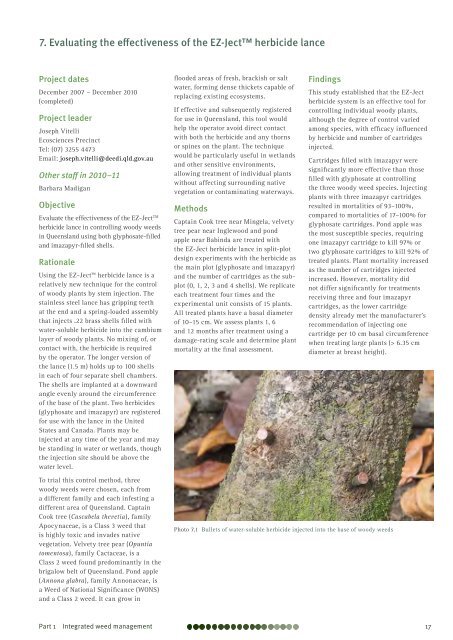Technical highlights - Department of Primary Industries ...
Technical highlights - Department of Primary Industries ...
Technical highlights - Department of Primary Industries ...
Create successful ePaper yourself
Turn your PDF publications into a flip-book with our unique Google optimized e-Paper software.
7. Evaluating the effectiveness <strong>of</strong> the EZ‑Ject herbicide lance<br />
Project dates<br />
December 2007 – December 2010<br />
(completed)<br />
Project leader<br />
Joseph Vitelli<br />
Ecosciences Precinct<br />
Tel: (07) 3255 4473<br />
Email: joseph.vitelli@deedi.qld.gov.au<br />
Other staff in 2010–11<br />
Barbara Madigan<br />
Objective<br />
Evaluate the effectiveness <strong>of</strong> the EZ-Ject TM<br />
herbicide lance in controlling woody weeds<br />
in Queensland using both glyphosate-filled<br />
and imazapyr-filled shells.<br />
Rationale<br />
Using the EZ-Ject herbicide lance is a<br />
relatively new technique for the control<br />
<strong>of</strong> woody plants by stem injection. The<br />
stainless steel lance has gripping teeth<br />
at the end and a spring-loaded assembly<br />
that injects .22 brass shells filled with<br />
water-soluble herbicide into the cambium<br />
layer <strong>of</strong> woody plants. No mixing <strong>of</strong>, or<br />
contact with, the herbicide is required<br />
by the operator. The longer version <strong>of</strong><br />
the lance (1.5 m) holds up to 100 shells<br />
in each <strong>of</strong> four separate shell chambers.<br />
The shells are implanted at a downward<br />
angle evenly around the circumference<br />
<strong>of</strong> the base <strong>of</strong> the plant. Two herbicides<br />
(glyphosate and imazapyr) are registered<br />
for use with the lance in the United<br />
States and Canada. Plants may be<br />
injected at any time <strong>of</strong> the year and may<br />
be standing in water or wetlands, though<br />
the injection site should be above the<br />
water level.<br />
To trial this control method, three<br />
woody weeds were chosen, each from<br />
a different family and each infesting a<br />
different area <strong>of</strong> Queensland. Captain<br />
Cook tree (Cascabela thevetia), family<br />
Apocynaceae, is a Class 3 weed that<br />
is highly toxic and invades native<br />
vegetation. Velvety tree pear (Opuntia<br />
tomentosa), family Cactaceae, is a<br />
Class 2 weed found predominantly in the<br />
brigalow belt <strong>of</strong> Queensland. Pond apple<br />
(Annona glabra), family Annonaceae, is<br />
a Weed <strong>of</strong> National Significance (WONS)<br />
and a Class 2 weed. It can grow in<br />
flooded areas <strong>of</strong> fresh, brackish or salt<br />
water, forming dense thickets capable <strong>of</strong><br />
replacing existing ecosystems.<br />
If effective and subsequently registered<br />
for use in Queensland, this tool would<br />
help the operator avoid direct contact<br />
with both the herbicide and any thorns<br />
or spines on the plant. The technique<br />
would be particularly useful in wetlands<br />
and other sensitive environments,<br />
allowing treatment <strong>of</strong> individual plants<br />
without affecting surrounding native<br />
vegetation or contaminating waterways.<br />
Methods<br />
Captain Cook tree near Mingela, velvety<br />
tree pear near Inglewood and pond<br />
apple near Babinda are treated with<br />
the EZ-Ject herbicide lance in split-plot<br />
design experiments with the herbicide as<br />
the main plot (glyphosate and imazapyr)<br />
and the number <strong>of</strong> cartridges as the subplot<br />
(0, 1, 2, 3 and 4 shells). We replicate<br />
each treatment four times and the<br />
experimental unit consists <strong>of</strong> 15 plants.<br />
All treated plants have a basal diameter<br />
<strong>of</strong> 10–15 cm. We assess plants 1, 6<br />
and 12 months after treatment using a<br />
damage-rating scale and determine plant<br />
mortality at the final assessment.<br />
Findings<br />
This study established that the EZ-Ject<br />
herbicide system is an effective tool for<br />
controlling individual woody plants,<br />
although the degree <strong>of</strong> control varied<br />
among species, with efficacy influenced<br />
by herbicide and number <strong>of</strong> cartridges<br />
injected.<br />
Cartridges filled with imazapyr were<br />
significantly more effective than those<br />
filled with glyphosate at controlling<br />
the three woody weed species. Injecting<br />
plants with three imazapyr cartridges<br />
resulted in mortalities <strong>of</strong> 93–100%,<br />
compared to mortalities <strong>of</strong> 17–100% for<br />
glyphosate cartridges. Pond apple was<br />
the most susceptible species, requiring<br />
one imazapyr cartridge to kill 97% or<br />
two glyphosate cartridges to kill 92% <strong>of</strong><br />
treated plants. Plant mortality increased<br />
as the number <strong>of</strong> cartridges injected<br />
increased. However, mortality did<br />
not differ significantly for treatments<br />
receiving three and four imazapyr<br />
cartridges, as the lower cartridge<br />
density already met the manufacturer’s<br />
recommendation <strong>of</strong> injecting one<br />
cartridge per 10 cm basal circumference<br />
when treating large plants (> 6.35 cm<br />
diameter at breast height).<br />
Photo 7.1 Bullets <strong>of</strong> water-soluble herbicide injected into the base <strong>of</strong> woody weeds<br />
Part 1 Integrated weed management 17

















